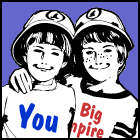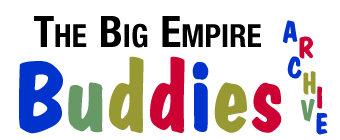


One of the fringe benefits of my former job was free admission to the Museum of Television and Radio, on 52nd street in Manhattan. There, I could sit in plush leather chairs and listen to old radio broadcasts while gazing out the window at the building across the way. I could also search their database for old TV programs, and watch those on a university-library-esque video terminal. And to top it all off, I was able to watch special programs in their screening rooms. Once I saw Woody Allen's early comedy stylings on TV, and they're always running some kind of program of old commercials, which is always good for a laugh.
Of course, I could still do all this now, only I would have to pay for it. No matter how little I went when it cost me nothing, it seemed like a regular occurrence compared to these days. Now that I have to pay six bucks like the mass of tourists sick of looking at paintings and sculptures, but still determined to visit as many buildings with the word "museum" in their name as they possibly can, I stay away from that place like it's infected with herpes and in a kissing mood.
This summer, however, the museum's program includes a series of screenings of Rocky and Bullwinkle, and other cartoons by Jay Ward. What I remember of Rocky and Bullwinkle is a lot of really terrible puns, and Dudley Do-Right's massive chin. But the press kept hammering away the point that there is much more to the cartoons than Bullwinkle lifting weights and saying things about his, "mooscles." I didn't believe it, but figured, what the hell? It's a way to watch cartoons and pretend like I'm getting me some culture.
I showed up at the museum about ten minutes before the screening was to begin. It didn't leave me much time to check out the rest of the goings-on, but that's all right, because there generally isn't much going on at the museum. The main attraction is the archive of shows and the screenings, so they've severely limited their wandering-around space.
Inside the screening room, I was met with a lot of empty chairs and just two other people. Apparently all the rabid Rocky and Bullwinkle fans had gotten their fill already. I took my seat and couldn't help but overhear the other people in the room. This is primarily because they were speaking as loudly as they could, and kept looking over at me to make sure I was taking in all their witty banter. Finally, another woman came in the room. She sat near me and pulled out a newspaper. After a couple of minutes, she leaned over to me, put her paper up near her face, and asked, about the jabbering duo, "Could they be any more annoying?" I figured her line would be the highlight of the evening's program.
The tape started to roll, and after a couple previews of upcoming programs at the museum and Candace Bergen making a plea for us to donate to the museum, the very first Jay Ward cartoon, "Crusader Rabbit," flickered on the screen. I happened, purely by luck, to have attended an encore of the "Rarely Seen Episodes" portion of the series. Crusader Rabbit first appeared in 1949, and was the first animated cartoon ever produced for television. It showed. To say the animation was rudimentary would be understating it by a great deal. Except for a few basic motions, the characters mostly just stood still while a voice narrated. The annoying male half of the annoying duo kept pointing at the screen and saying, "They're not moving! They're not moving!"
Lazy animation aside, I found myself laughing out loud quite a bit. The plot of the first episode involved Crusader Rabbit going to Texas to stop the Texans from running all the rabbits out of their state. The narrator informed us that Crusader Rabbit wasn't afraid of Texans because "Texans are all singers," but he was a little spooked by their horses. In the next episode, a villainous pirate hatched a plot to steal all of the silverware from New York City, with the help of a nine-armed octopus whom he had trained as the finest pick-pocket in the land.
With my finely-tuned analytical mind, I noticed that Crusader Rabbit and his big, goofy-voiced sidekick, Ragland Tiger, were sort of precursors to Rocky the squirrel and Bullwinkle Moose. I also took note of the female member of the annoying duo, and her annoying habit of saying, "that's cute!" after every cartoon ended.
The program skips ahead 10 years to the premier of the squirrel/moose combo. At the time, the show was entitled, "Rocky and His Friends." My guess is that the squeaky squirrel got on people's nerves, because he eventually got booted from the title. By 1961, the show was called "The Bullwinkle Show."
Even in its first episode, the familiar gags were all present. Bullwinkle tries to pull a rabbit out of his hat, Rocky scolds him, saying it will never work, and Boris Badenov and Natasha Fatale try to kill the poor moose and squirrel. My personal favorite character, Mr. Peabody, was introduced, with a story of how he adopted, "his boy," Sherman. Once again, I found myself laughing much more than I expected to. Maybe those newspaper writers aren't so dopey after all.
In 1961, "The Bullwinkle Show" debuted, in color. The animation hadn't much improved, but it made little difference. Who needs flashy effects when you can toss off lines like, "...they rode fourth class, which meant they walked on the railroad ties," about train travel?
Part of the beauty of seeing the show at the museum, instead of on cable, is that the museum leaves in the commercials from the original episodes. The Scottish kids dying for Kool-Aid got big laughs from the crowd which had filtered in during the program, but the portion of the show which was most talked about in the elevator on the way down was the ad for Frosty-O's cereal. The mysterious energy-enhancing properties of the cereal were explained - turns out the flakes were "sugar-charged!"
A couple of other added bonuses included a Bullwinkle puppet which appeared on "The Bullwinkle Show," and, in a pale imitation of Pookie from the "Soupy Sales Show," as a foil for a real person on "Fractured Flickers," as well as a film showing Jay Ward in action. Being the wacky guy that he was, Ward used the segment to mock himself, his writers, and studio executives mercilessly.
The show gave me plenty of laughs, and the annoying couple left about ten minutes early. I can't imagine it going any better than that.